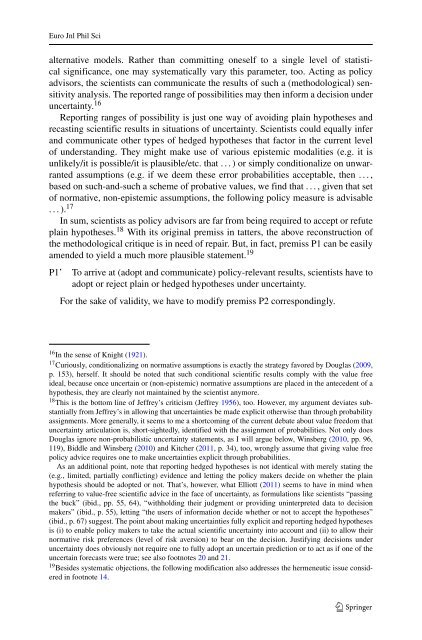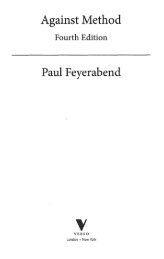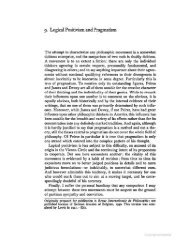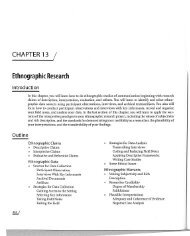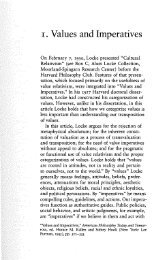In defence of the value free ideal
In defence of the value free ideal
In defence of the value free ideal
- No tags were found...
You also want an ePaper? Increase the reach of your titles
YUMPU automatically turns print PDFs into web optimized ePapers that Google loves.
Euro Jnl Phil Scialternative models. Ra<strong>the</strong>r than committing oneself to a single level <strong>of</strong> statisticalsignificance, one may systematically vary this parameter, too. Acting as policyadvisors, <strong>the</strong> scientists can communicate <strong>the</strong> results <strong>of</strong> such a (methodological) sensitivityanalysis. The reported range <strong>of</strong> possibilities may <strong>the</strong>n inform a decision underuncertainty. 16Reporting ranges <strong>of</strong> possibility is just one way <strong>of</strong> avoiding plain hypo<strong>the</strong>ses andrecasting scientific results in situations <strong>of</strong> uncertainty. Scientists could equally inferand communicate o<strong>the</strong>r types <strong>of</strong> hedged hypo<strong>the</strong>ses that factor in <strong>the</strong> current level<strong>of</strong> understanding. They might make use <strong>of</strong> various epistemic modalities (e.g. it isunlikely/itispossible/itisplausible/etc.that...)orsimplyconditionalize on unwarrantedassumptions (e.g. if we deem <strong>the</strong>se error probabilities acceptable, <strong>the</strong>n ...,basedonsuch-and-suchascheme<strong>of</strong>probative<strong>value</strong>s,wefindthat...,giventhatset<strong>of</strong> normative, non-epistemic assumptions, <strong>the</strong> following policy measure is advisable...). 17<strong>In</strong> sum, scientists as policy advisors are far from being required to accept or refuteplain hypo<strong>the</strong>ses. 18 With its original premiss in tatters, <strong>the</strong> above reconstruction <strong>of</strong><strong>the</strong> methodological critique is in need <strong>of</strong> repair. But, in fact, premiss P1 can be easilyamended to yield a much more plausible statement. 19P1’ To arrive at (adopt and communicate) policy-relevant results, scientists have toadopt or reject plain or hedged hypo<strong>the</strong>ses under uncertainty.For <strong>the</strong> sake <strong>of</strong> validity, we have to modify premiss P2 correspondingly.16 <strong>In</strong> <strong>the</strong> sense <strong>of</strong> Knight (1921).17 Curiously, conditionalizing on normative assumptions is exactly <strong>the</strong> strategy favored by Douglas (2009,p. 153), herself. It should be noted that such conditional scientific results comply with <strong>the</strong> <strong>value</strong> <strong>free</strong><strong>ideal</strong>, because once uncertain or (non-epistemic) normative assumptions are placed in <strong>the</strong> antecedent <strong>of</strong> ahypo<strong>the</strong>sis, <strong>the</strong>y are clearly not maintained by <strong>the</strong> scientist anymore.18 This is <strong>the</strong> bottom line <strong>of</strong> Jeffrey’s criticism (Jeffrey 1956), too. However, my argument deviates substantiallyfrom Jeffrey’s in allowing that uncertainties be made explicit o<strong>the</strong>rwise than through probabilityassignments. More generally, it seems to me a shortcoming <strong>of</strong> <strong>the</strong> current debate about <strong>value</strong> <strong>free</strong>dom thatuncertainty articulation is, short-sightedly, identified with <strong>the</strong> assignment <strong>of</strong> probabilities. Not only doesDouglas ignore non-probabilistic uncertainty statements, as I will argue below, Winsberg (2010, pp. 96,119), Biddle and Winsberg (2010) and Kitcher (2011, p. 34), too, wrongly assume that giving <strong>value</strong> <strong>free</strong>policy advice requires one to make uncertainties explicit through probabilities.As an additional point, note that reporting hedged hypo<strong>the</strong>ses is not identical with merely stating <strong>the</strong>(e.g., limited, partially conflicting) evidence and letting <strong>the</strong> policy makers decide on whe<strong>the</strong>r <strong>the</strong> plainhypo<strong>the</strong>sis should be adopted or not. That’s, however, what Elliott (2011) seemstohaveinmindwhenreferring to <strong>value</strong>-<strong>free</strong> scientific advice in <strong>the</strong> face <strong>of</strong> uncertainty, as formulations like scientists “passing<strong>the</strong> buck” (ibid., pp. 55, 64), “withholding <strong>the</strong>ir judgment or providing uninterpreted data to decisionmakers” (ibid., p. 55), letting “<strong>the</strong> users <strong>of</strong> information decide whe<strong>the</strong>r or not to accept <strong>the</strong> hypo<strong>the</strong>ses”(ibid., p. 67) suggest. The point about making uncertainties fully explicit and reporting hedged hypo<strong>the</strong>sesis (i) to enable policy makers to take <strong>the</strong> actual scientific uncertainty into account and (ii) to allow <strong>the</strong>irnormative risk preferences (level <strong>of</strong> risk aversion) to bear on <strong>the</strong> decision. Justifying decisions underuncertainty does obviously not require one to fully adopt an uncertain prediction or to act as if one <strong>of</strong> <strong>the</strong>uncertain forecasts were true; see also footnotes 20 and 21.19 Besides systematic objections, <strong>the</strong> following modification also addresses <strong>the</strong> hermeneutic issue consideredin footnote 14.


